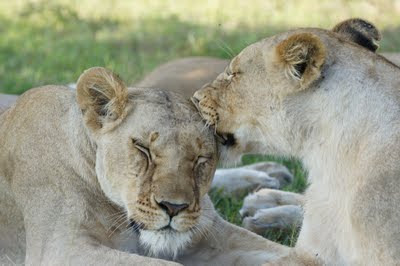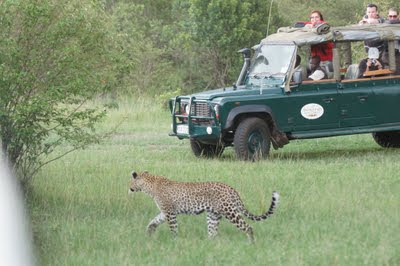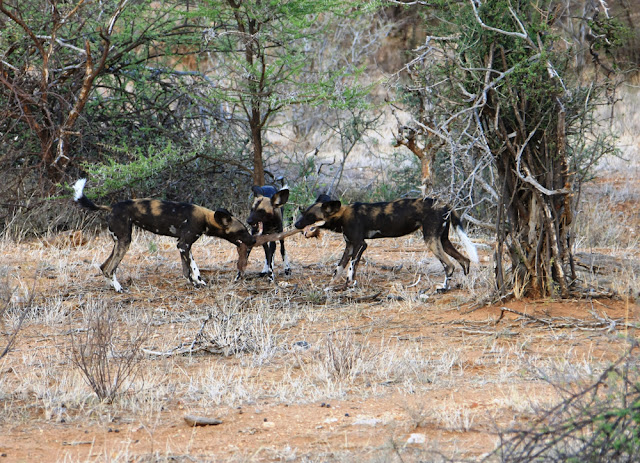Overview
It’s raining every afternoon in Maasai Mara but despite that the rivers are still low. The plains are already full of tall red oat grass especially between the Talek and Olare Orok rivers and also in the southern part of Mara Intrepid camp and the Possee Plain all the way down to the border of Mara and the Serengeti.
The area between Rhino Ridge and Paradise Plain to the main crossing at Mara River is also covered with tall grass, forcing all the herbivores to seek refuge in places with short grass in the eastern and northern part of the Ridge.
The long rains were not wide spread this year, so some parts of the reserve and its adjacent areas are drying up and hence forcing the herbivores to move into the reserve early than expected. The Loita herds of wildebeest and zebras are here, roaming from Musiara Marsh to the game reserve border. Other places with high concentration of plain game are west of Lookout Hill, across Talek River south of Mara Intrepids Camp and Maji-ya-Eland, west of Mara Intrepids Camp and Maji-ya-Fisi and Shamarta and Paradise Plain.
Big Cats Sightings
Lions
Some of the prides are still enjoying the herds of wildebeest, especially the Marsh Pride, the Ridge Pride and the Olkiombo Pride.
The Marsh Pride is still intact with their old males.
The Ridge Pride has separated into four groups of different numbers occupying small sections of their territory. Between Olare Orok and Intiakitiak there are 32 lions including Notch and his sons. A group of four lionesses and eight cubs of seven months are found between Mara Intrepids Camp and Rekero Camp going further to the junction of Mara River and Talek River. Notch and his sons are in charge of the group.
The Olkiombo Pride has split into three groups and has increased to 42 lions.
One group of 12 individuals which in the last three years had moved to the Olare Orok Conservancy is back in the game reserve occupying Chuvi-Chuvi along Intiakitiak River. It has eight cubs of three years old and four lionesses. It looks like Notch and his four sons might take over this pride as they have been seen trailing the pride.
Four lionesses, four sub-adults and three cubs from the Olkiombo Pride are between Fig Tree Camp and Mara Intrepids Camp. When Cheza, Sala and Junior took over Maji-ya-Fisi Pride, a group of three lionesses and nine cubs of two years followed them. Now they have six cubs of nine month and three males which make a total of 22 members.
Leopards
Sadly Olive lost one of her two cubs between Mara Intrepids Camp and Double Crossing. She has been seen roaming with Kayoni and her surviving one-year-old cub. Pacha is wandering along Olare Orok up to Rhino Ridge and marking his territory.
Big Boy has not seen of recent but when last he was seen with a badly wounded back leg.
Cheetahs
The three brothers moved to OOC with Shingo the mother of six cubs and three junior brothers south of Mara Intrepids Camp towards Lookout Hill.
Two young expectant females are at Bila Shaka and Topi Plain. Saba and Alama who were at Olkiombo have moved west of Mara Intrepids Camp.
*Did you know the Disney movie, African Cats was shot near Mara Intrepids and Explorer camps? Well now you know!
Report by Dixon Chelule, Assistant Head Guide Mara Intrepids Camp and Paul Kirui, Head Guide, Heritage Hotels. Pictures by Dixon Chelule and Paul Kirui.
24 June, 2011
Excellent Game Viewing in Samburu
Recently, guests guests at Samburu Intrepids were treated to an exciting game drive.
As we crossed a small creek opposite Serena Lodge, we came across a pack of the African wild dogs, one of the most endangered canine species in Africa. The African wild dog has a unique way of hunting. The pack will chase the prey until it is exhausted.
Within seconds, the pack had brought down a male dik dik….and all fought to have a piece of the meat.
Soon after feasting on the dik dik, the pack of 14 climbed a hill to rest.
Facts on the African Wild Dog
Unique creatures seen on a game drive
Gerenuks, derived from the Samburu name meaning 'giraffe antelopes' browse in the morning and evening. The gerenuk is one of the 'special five' of Samburu - the others are the Somali ostrich, reticulated giraffe, Grevy's zebra and Beisa's oryx.
They stand on their hind legs to reach the shrubs.
Cheetah hunt caught on camera!
North of Samburu Lodge we saw a cheetah and her two cubs. We followed them patiently as they looked a bit hungry, and our hunch was rewarded pretty soon - a hunt was just about to begin!
Target in sight - a dik dik (this is one of the smallest antelopes, found only in the northern parts of Kenya).
The dik dik tried its best to flee for safety but in vain - he didn't stand a chance. Out flanked, out run and over powered by the fastest predator on land, the battle was over before it begun! The mother cheetah was also using the dik dik to train her cubs how to hunt because as soon as they are adults they have to hunt on their own. She also ate last, maybe recognising that they were tired and she - matrimonially - was still looking out for them.
Fun facts about dik diks:
Habitat: Dik diks live mostly in semi arid regions with low bush along dry, rocky stream beds
Behavior: Dik diks form monogamous pairs in that reside in fixed territories. They mark their territory with dung deposits and with secretions from the preorbital gland.
Sight, scent and hearing are well-developed and they are very alert.
They respond to the alarm calls of other animals. When in danger they hide.
Report by Francis Lenyakopiro, Culturalist / Naturalist at Samburu Intrepids Club. Pictures by Francis Lenyakopiro, Barbara Minishi and Ndeithi Kariuki.
As we crossed a small creek opposite Serena Lodge, we came across a pack of the African wild dogs, one of the most endangered canine species in Africa. The African wild dog has a unique way of hunting. The pack will chase the prey until it is exhausted.
Within seconds, the pack had brought down a male dik dik….and all fought to have a piece of the meat.
Soon after feasting on the dik dik, the pack of 14 climbed a hill to rest.
Facts on the African Wild Dog
The African wild dog is also called the 'Cape hunting dog' or 'painted dog'. The dog's Latin name means "painted wolf," referring to the animal's irregular, mottled coat. Each animal has a unique coat pattern, and all have big, rounded ears.
It typically roams the open plains and sparse woodlands of sub-Saharan Africa. These long-legged canines have only four toes per foot, unlike other dogs, which have five toes on their forefeet.
African wild dogs live in packs that are usually dominated by a monogamous breeding pair.The female has a litter of two to 20 pups, which are cared for by the entire pack. These dogs are very social, and packs have been known to share food. They also help weak or ill members. Social interactions are common, and the dogs communicate by touch, actions, and vocalizations.
African wild dogs hunt in formidable, packs of six to 20 (or more) animals. Larger packs were more common before the dogs became endangered. Packs hunt antelopes and will also tackle much larger prey, such as wildebeests, particularly if their quarry is ill or injured. The dogs supplement their diet with rodents and birds.
As human settlements expand, the dogs have develop a taste for livestock, though significant damage is rare. Unfortunately, the dogs are often hunted and killed by farmers in revenge for killing their livestock.
African hunting dogs are endangered. They are faced with habitat loss and are also susceptible to diseases spread by domestic animals.
Unique creatures seen on a game drive
Gerenuks, derived from the Samburu name meaning 'giraffe antelopes' browse in the morning and evening. The gerenuk is one of the 'special five' of Samburu - the others are the Somali ostrich, reticulated giraffe, Grevy's zebra and Beisa's oryx.
They stand on their hind legs to reach the shrubs.
These antelopes live in herds of six to 10 animals with one territorial male and females.
Orange breasted parrot. beautiful ain't he?
Bush Buck.
Vulturine guine-fowl - only found in northern Kenya
The desert rose - pretty but poisonous.
We came across this fella near Samburu Intrepids. He was about 2 and a half metres long!
Menacing look.
Cheetah hunt caught on camera!
North of Samburu Lodge we saw a cheetah and her two cubs. We followed them patiently as they looked a bit hungry, and our hunch was rewarded pretty soon - a hunt was just about to begin!
Target in sight - a dik dik (this is one of the smallest antelopes, found only in the northern parts of Kenya).
The dik dik tried its best to flee for safety but in vain - he didn't stand a chance. Out flanked, out run and over powered by the fastest predator on land, the battle was over before it begun! The mother cheetah was also using the dik dik to train her cubs how to hunt because as soon as they are adults they have to hunt on their own. She also ate last, maybe recognising that they were tired and she - matrimonially - was still looking out for them.
Fun facts about dik diks:
Habitat: Dik diks live mostly in semi arid regions with low bush along dry, rocky stream beds
Behavior: Dik diks form monogamous pairs in that reside in fixed territories. They mark their territory with dung deposits and with secretions from the preorbital gland.
Sight, scent and hearing are well-developed and they are very alert.
They respond to the alarm calls of other animals. When in danger they hide.
Report by Francis Lenyakopiro, Culturalist / Naturalist at Samburu Intrepids Club. Pictures by Francis Lenyakopiro, Barbara Minishi and Ndeithi Kariuki.
Subscribe to:
Comments (Atom)
























